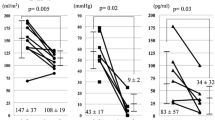Summary
Clinical, echocardiographic, hemodynamic, and angiographic findings were reviewed in 16 consecutive patients with tricuspid atresia (TA) and normally related great arteries, seen at the University of Florida between 1984 and 1990, to determine when and in which patients hypercyanotic spells (HS), unrelated to ductal constriction, occurred. Such spells developed in six patients (38%) and were life-threatening and refractory to medical management in three patients. Most HS (five of six) occurred in the first 2 months of life. Angiography done at the time of diagnosis revealed similar morphological features in all patients subsequently experiencing HS; infundibular stenosis due to anterior malalignment of the conal septum. These findings suggest a predisposition for development of early HS in TA patients with apparent infundibular stenosis due to anterior malalignment of the conal septum. Further study and a heightened clinical awareness are needed in such patients.
Similar content being viewed by others
References
Anderson RH, Wilkinson JL, Gerlis LAR, et al. (1977) Atresia of the right atrioventricular orifice.Br Heart J 39:414–428
Ben-Shackar G, Cohen MH, Sivakoff ML, et al. (1985) Development of infundibular obstruction after percutaneous pulmonary balloon valvuloplasty.J Am Coll Cardiol 5:754–756
Bharati S, McAllister HA, Tatooles CJ, et al. (1976) Anatomic variations in underdeveloped right ventricle related to tricuspid atresia and stenosis.J Thorac Cardiovasc Surg 72:383–400
Bricker JT (1990) Clinical physiology of right to left shunts. In: Garson AJ, Bricker JT, McNamara DG (eds)The science and practice of pediatric cardiology 1990. Lea and Ferberger, Malvern, PA, pp 1070–1072
Dick ME, Fyler DC, Nadas AS (1975) Tricupsid atresia: clinical course in 101 patients.Am J Cardiol 36:327–337
Dolara A, Fazzini PF, Marchi F, et al. (1969) Changing clinical features in tricuspid atresia without transposition of great vessels: a report of two cases.Acta Cardiol 24:275–284
Ottenkamp J, Wenink ACG, Quaegebauer JM, et al. (1985) Tricuspid atresia: morphology of outlet chamber with special emphasis on surgical implications.J Thorac Cardiovasc Surg 89:597–603
Rao PS (1980) A unified classification for tricuspid atresia.Am Heart J 99:799–804
Rao PS (1982) Natural history of ventricular septal defect in tricuspid atresia. In: Rao PS (ed)Tricuspid atresia 1982. Futura Publishing Company, New York, pp 201–229
Rao PS (1982) Classification of tricuspid atresia. In: Rao PS (ed)Tricspid atresia 1992. Futura Publishing Co, New York, pp 59–79
Rao PS, Linde LM, Lieberman J, etal. (1974) Functional closure of physiologically advantageous ventricular septal defects: observations in three cases with tricuspid atresia.Am J Dis Child 127:36
Rigby ML, Carvalho JS, Anderson RH, Redington A (1990) The investigation and diagnosis of tricuspid atresia.Int J Cardiol 27:1–17
Author information
Authors and Affiliations
Rights and permissions
About this article
Cite this article
Holmes, G., Epstein, M.L. Early hypercyanotic spells unrelated to ductal constriction in tricuspid atresia with infundibular stenosis. Pediatr Cardiol 14, 151–154 (1993). https://doi.org/10.1007/BF00795643
Issue Date:
DOI: https://doi.org/10.1007/BF00795643




